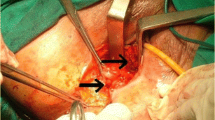Abstract
PURPOSE: We categorized the various types of postobstetric injuries of the anorectum and vagina encountered in a five-year period. The operative procedures used to repair these injuries and the functional outcome after surgery were assessed. METHODS: Between 1986 and 1991, 52 patients were surgically treated for obstetric injuries of the anorectum and vagina; 48 patients were available for follow-up study. Four clinical injury types were identified: Type I, incontinent anal sphincter (11 patients); Type II, rectovaginal fistula (16 patients); Type III, rectovaginal fistula and incontinent anal sphincter (11 patients); and Type IV, cloaca-like defect (10 patients). The mean age of the patients was 30 years, the mean duration of symptoms before surgery was 13 months, and the mean follow-up period was 16 months. The major component of surgical repair for each injury type was: Type I, overlap repair of external anal sphincter; Type II, rectal mucosal advancement flap; Type III, overlap repair of external anal sphincter and rectal mucosal advancement flap; and Type IV, overlap repair of external anal sphincter, anterior levatorplasty, and anal and vaginal mucosal reconstruction. Fecal diversion was not performed in any patient. Specific questions were asked at the most recent follow-up assessment to determine results. RESULTS: Continence status postoperatively was classified as perfect, impaired, or poor; poor was defined as no improvement or worse. Postoperative continence (perfect, impaired, or poor) was, respectively: Type I (11 patients), 64 percent, 36 percent, and 0 percent; Type II (16 patients), 56 percent, 0 percent, and 44 percent; Type III (11 patients), 64 percent, 36 percent, and 0 percent; and Type IV (10 patients), 90 percent, 10 percent, and 0 percent. Vaginal discharge of stool was eliminated in all patients with a rectovaginal fistula. Subjectively, 92 percent of the patients had excellent or good results. Complications included wound hematoma (n=2), fecal impaction (n=2), urinary retention (n=1), and urinary tract infection (n=1). CONCLUSION: Patients with Type II injuries had the worst results (P < 0.001). These patients should be evaluated for anal incontinence before surgery to assess the need for a concomitant sphincteroplasty.
Similar content being viewed by others
References
Venkatesh KS, Ramanujam PS, Larson DM, Haywood MA. Anorectal complications of vaginal delivery. Dis Colon Rectum 1989;32:1039–41.
Wexner SD, Marchetti F, Jagelman DG. The role of sphincteroplasty for fecal incontinence reevaluated: a prospective physiologic and functional review. Dis Colon Rectum 1991;34:22–30.
Wise WE Jr, Aguilar PS, Padmanabhan A, Meesig DM, Arnold MW, Stewart WR. Surgical treatment of low rectovaginal fistulas. Dis Colon Rectum 1991;34:271–4.
Fang DT, Nivatvongs S, Vermuelen FD, Herman FN, Goldberg SM, Rothenberger DA. Overlapping sphincteroplasty for acquired anal incontinence. Dis Colon Rectum 1984;27:720–2.
Laurberg S, Swash M, Henry MM. Delayed external sphincter repair for obstetric tear. Br J Surg 1988;75:786–8.
Keighley MR, Oya M, Oritz J, Pinho M, Asperer J, Chattaphaday G. What is the optimum pelvic floor repair for neuropathic fecal incontinence? (meeting abstr). Dis Colon Rectum 1991;34:P6.
Author information
Authors and Affiliations
About this article
Cite this article
Khanduja, K.S., Yamashita, H.J., Wise, W.E. et al. Delayed repair of obstetric injuries of the anorectum and vagina. Dis Colon Rectum 37, 344–349 (1994). https://doi.org/10.1007/BF02053595
Issue Date:
DOI: https://doi.org/10.1007/BF02053595



